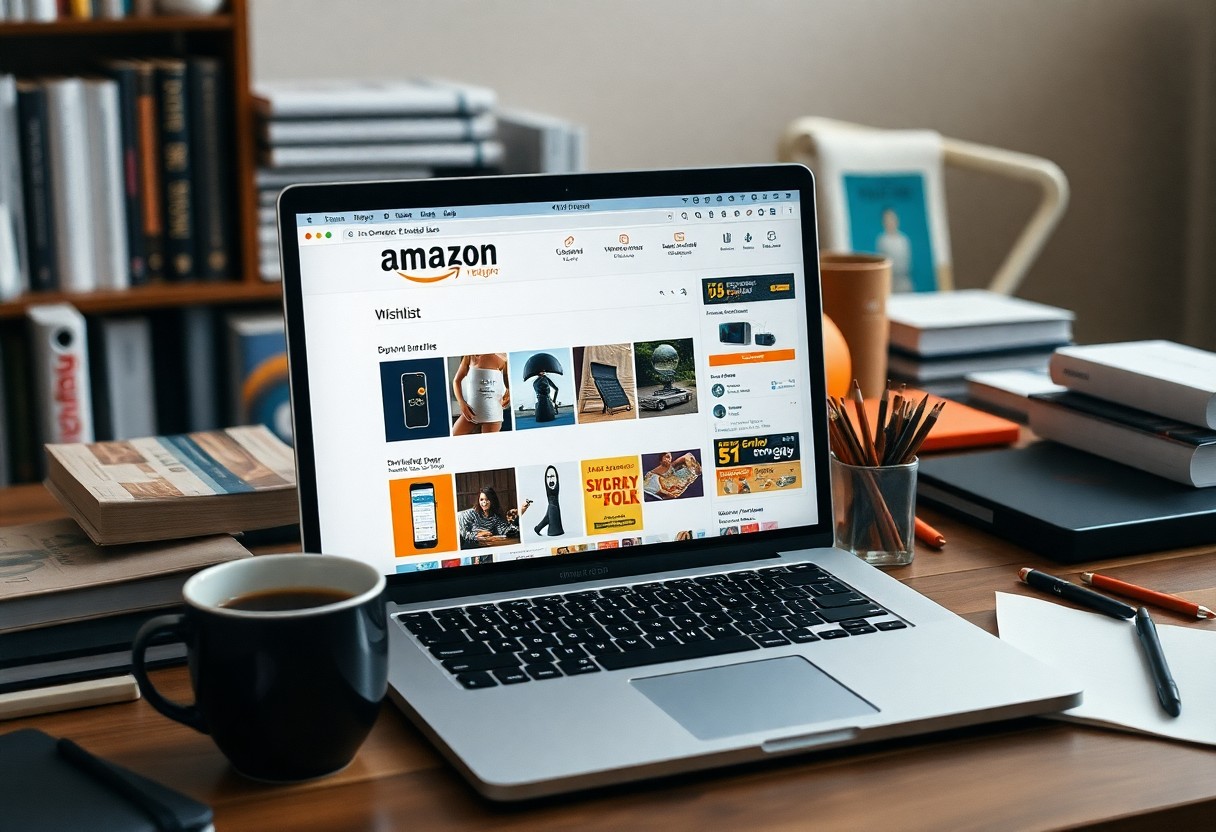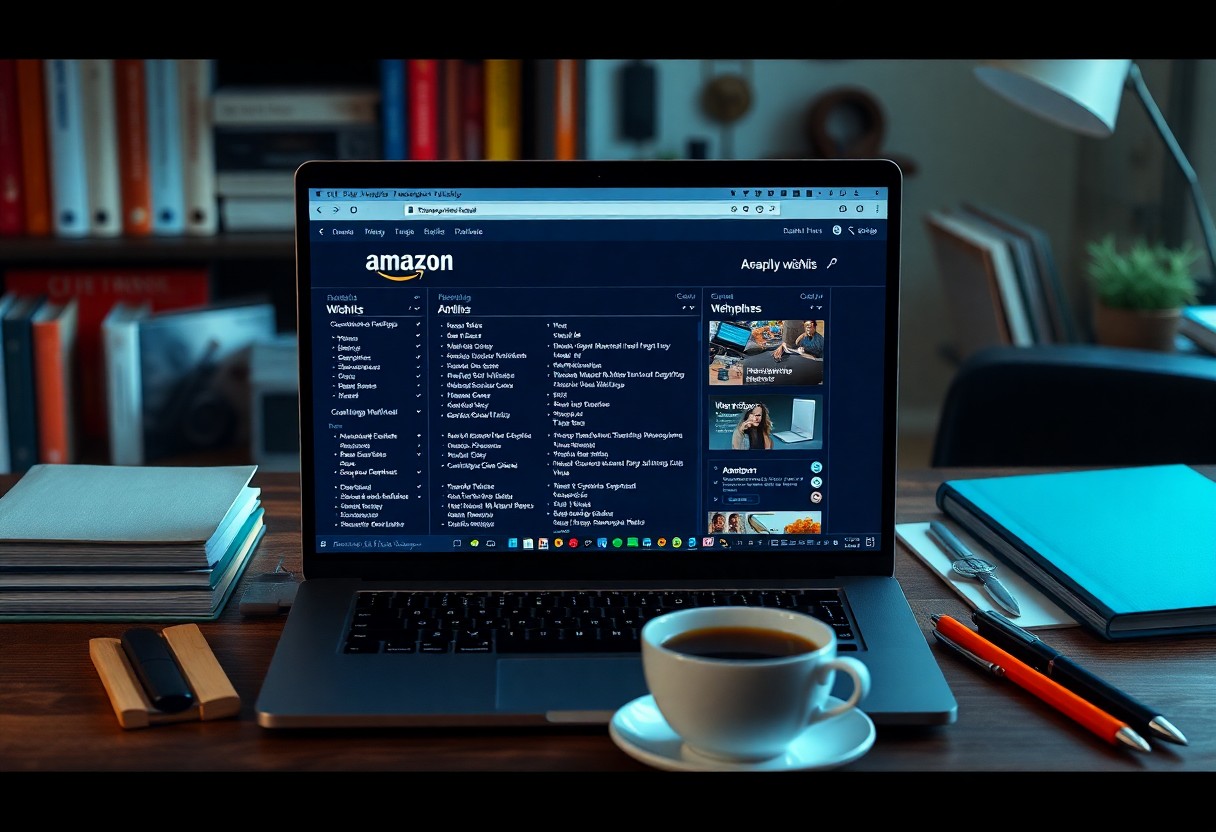Savvy How-To Guide For Maximizing Your Amazon Wishlist
Just like any savvy shopper, you want to make the most of your Amazon Wishlist to enhance your shopping experience. This guide will empower you to organize your items effectively, set priorities for purchases, and use features that keep you in the loop about deals and discounts. By optimizing your wishlist, you’ll not only prevent wasteful spending, but also ensure you never miss out on that perfect item again. Get ready to transform your Amazon Wishlist into a powerful tool that serves your shopping goals!
Understanding Your Amazon Wishlist
What is an Amazon Wishlist?
Your Amazon Wishlist is a personalized feature on the Amazon platform that allows you to compile a curated list of products that you wish to purchase in the future. Any user can easily create this list, enabling them to keep track of items that catch their fancy, whether it’s a pair of shoes, a new book, or that state-of-the-art kitchen gadget you’ve been eyeing. This functionality is particularly useful for organizing your shopping desires and planning ahead for birthdays, holidays, or even personal splurges. You have the flexibility to add and update items at any time, which gives you a lot of control over your potential purchases.
Additionally, your Wishlist can be shared with friends and family, making it an excellent tool for gift-giving occasions. Any person with access to your list can view the products you want, ensuring that you receive gifts you’ll actually appreciate. This social sharing aspect not only enhances the gifting experience but also prevents the all-too-common occurrence of receiving duplicates or unwanted items. Moreover, you can keep your Wishlist private if you prefer to keep your shopping intentions to yourself.
Furthermore, your Amazon Wishlist can be a valuable assistant for budgeting and planning your purchases. Any time you find an item that you want, instead of making an impulsive buy, you can add it to your Wishlist. This encourages you to take a moment to consider whether the item is indeed necessary or if a cheaper alternative exists. By maintaining a Wishlist, you can make informed decisions about what to buy when the time is right.
Benefits of Using an Amazon Wishlist
One of the key advantages of using an Amazon Wishlist is the ability to prioritize your shopping needs effectively. By organizing items according to importance or urgency, you can ensure that your most desired goods are always at the top of your list. This feature helps you avoid overspending on impulsive purchases while providing a clear roadmap of what you truly want. Not only does this save you time when browsing, but it also helps align your spending habits with your financial goals.
Another significant benefit is the convenience of having all your desired items in one location. One click takes you to a well-structured overview of what you’ve been thinking about buying, making it easier to compare prices and options. Additionally, Amazon often provides notifications about upcoming sales or price drops for items on your Wishlist, ensuring that you get the best possible deal when you decide to purchase. This proactive approach to shopping allows you to stretch your dollar further while still getting what you want.
Wishlist features can also enhance your overall shopping experience. From communal gift lists to managing shared Wishlist with a partner or family member, you foster collaboration and communication about what to buy for each other. Furthermore, you can set reminders for specific items, track changes in prices, and discover new recommendations based on your preferences. These elements all contribute to a more productive and enjoyable shopping journey.
How to Create and Organize Your Wishlist
If you want to take advantage of the many benefits of an Amazon Wishlist, you’ll need to set it up properly. The first step in that process is creating your wishlist. This feature allows you to compile all the products you’re interested in one convenient location, making it easier for you to track what you want as well as enabling you to share with friends and family during gift-giving occasions. Moreover, an organized wishlist can save you time and help you avoid those impulsive buys by allowing you to prioritize what truly matters to you.
To create your wishlist on Amazon, simply visit the Amazon website and log into your account. Look for the “Account & Lists” dropdown at the top right corner of the homepage. From there, click on “Create a List” and choose “Wish List.” Once your list is created, you can easily add items to it. Explore various categories and search options to find the products that pique your interest, and just click on the “Add to List” button. You can always edit the name of your list and its privacy settings based on who you want to share it with.
Organizing your wishlist effectively can enhance the shopping experience even further. You can categorize items based on personal preferences or occasions, like birthdays or holidays. Additionally, you may want to sort items by priority or necessity. Doing so not only brings order to chaos but also allows your loved ones to know exactly what to purchase for you based on your needs and desires.
Step-by-Step Guide to Setting Up Your Wishlist
Now that you understand the basic idea behind creating your wishlist, let’s examine deeper into a detailed method for setting it up efficiently. Below is a comprehensive layout of the steps you’ll need to follow:
| Step | Description |
| 1 | Log into your Amazon account. |
| 2 | Navigate to “Account & Lists” and select “Create a List.” |
| 3 | Name your wishlist and set privacy preferences. |
| 4 | Browse Amazon and add items to your wishlist. |
| 5 | Use the “Manage List” option for organizing or deleting items. |
Tips for Categorizing Items Efficiently
The efficiency of your wishlist significantly increases when you categorize your items wisely. Categorization enables you to quickly locate products and provides a more user-friendly experience, which is especially beneficial when your wishlist holds numerous items. Start by pondering what types of items you usually want or need, whether it’s electronics, beauty products, books, or home goods. Once you have established categories, use them as sublists within your main wishlist for better organization. This structured approach not only saves time but also assists your family and friends in gifting the right items.
- Always create subcategories under your main wishlist for easy navigation.
- Consider coding your wishes based on importance or urgency (urgent, medium, low).
- Review and update your categories regularly to fine-tune your wishlist.
Thou could also enhance the effectiveness of your organization by incorporating visual cues or tags that can make your wishlist items easily identifiable. Using distinct names or even emojis can help bring a personal touch to your wishlist, making it more engaging for you and the people you may share it with.
Tips for a more meticulous categorization include understanding the potential for overlapping categories and tweaking them to avoid confusion. While high-priority items may overlap with general desires, it’s beneficial to establish clear, dedicated categories. This straightforward method increases efficiency and ensures that you are focused on what matters the most while shopping for both necessities and wants.
- Utilize filters to sort through your wishlist items when searching.
- Periodic reviews can prevent clutter and maintain relevance in your wishlist.
- Stay mindful of what you truly need versus what you merely wish for once in a while.
Thou shall find that taking these steps transforms your wishlist into a highly functional and enjoyable tool for managing your shopping desires.
Factors to Consider When Adding Items
Even though creating an Amazon Wishlist can seem straightforward, making effective additions requires careful consideration of several factors. Taking the time to evaluate what you need versus what you want will help streamline your wishlist and ultimately, your purchasing decisions. As you explore various products, ask yourself the following questions:
- How often will I use this item?
- Is this product a necessity or a luxury?
- Am I purchasing it for myself, or as a gift for someone else?
- Does this item fit within my budget?
By focusing on these aspects, you gain a clearer perspective on whether an item deserves a spot on your wishlist or if it’s simply an impulsive desire. Prioritizing your needs will not only optimize your shopping experience but may also prevent buyer’s remorse down the road.
When considering items for your wishlist, it’s important to strike a balance between your needs and your wants. This requires thoughtful deliberation where you take into account what you genuinely require versus what might offer fleeting satisfaction. To fully leverage the capabilities of your Amazon Wishlist, you should continually assess your growth and lifestyle changes, ensuring your wishlist evolves with you. For instance, if you often find yourself adding items that seem appealing in the moment but don’t serve a lasting purpose, it’s time to reassess your objectives and focus on the importants.
Perceiving the big picture involves creating a wishlist that reflects your personal goals and aspirations. You might find that some items may actually prevent you from investing in what truly matters. It’s vital to cultivate a disciplined approach to adding products to your wishlist. Delve deeper into your priorities so that each item serves a purpose or enhances your life in a meaningful way. For additional insights on leveraging your wishlist effectively, consider exploring how Amazon sellers use the Amazon Wishlist to boost sales, and adjust your strategy to enhance your shopping experience.
Prioritizing Needs vs. Wants
Assuming you have already built an initial Amazon Wishlist, the next step is distinguishing between your needs and wants effectively. A prevalent challenge many face when curating their wishlist is getting swept away by the myriad of products available on the platform. This overwhelming variety can lead to impulsive choices that result in items being added for the sake of excitement rather than practicality. To prevent this pitfall, segment your wishlist by categories and highlight which items truly align with your ongoing needs versus momentary desires.
Your approach should steer more towards functional items that enhance your daily life, whether through convenience, productivity, or personal fulfillment. As you scrutinize each product, consider whether this item will genuinely serve a purpose or if it’s merely a passing fancy that may soon be forgotten. Keeping track of your core needs—like household tasks, work-related gear, or fitness importants—can allow you to allocate your budget more effectively and steer clear of unnecessary distractions that clutter your wishlist.
Over time, you may develop a better intuition about what you value most versus what is easily forgotten. Engaging in this reflective practice when managing your wishlist can empower you to curate a collection that not only meets your immediate requirements but also aligns with your long-term goals. This disciplined habit fosters a more intentional and fulfilling shopping experience, ultimately leading you to make savvy and enriching purchases.
Evaluating Product Helpfulness and Reviews
Factors to consider when evaluating product helpfulness and reviews are paramount. Your wishlist isn’t merely a shopping list; it’s a resource for informed decision-making. Before adding an item, seek out comprehensive feedback from other consumers. Look for product reviews that probe beyond simple ratings, and pay close attention to detailed comments that highlight the item’s strengths and weaknesses. A well-rounded review can shed light on aspects like durability, functionality, and overall value, ensuring you invest in products that will genuinely meet your expectations.
The inclusion of user experiences in the form of reviews serves as a reality check—offering insights that product descriptions alone cannot provide. Even items that seem perfect on paper can fall short in execution. To gather a balanced perspective, ensure you seek reviews from individuals who share similar needs or preferences. Their feedback will guide your decision and may even steer you away from items that frequently disappoint. Product comparisons can also be useful, as they allow you to evaluate alternatives that may better suit your requirements.
The amalgamation of product ratings, user comments, and comparative analysis significantly aides you in making wise additions to your wishlist. Avoid falling into the trap of choosing items solely based on hype or high ratings; instead, emphasize finding products that resonate with your lifestyle and offer substantial benefits. By honing in on the most important details, such as durability and value, you’ll end up with a wishlist that is not only impressive but truly reflective of your needs. This approach will ultimately guide you toward informed purchasing decisions that stand the test of time.

How to Share Your Wishlist with Others
Despite being a straightforward tool for managing potential purchases, your Amazon Wishlist also serves as a great platform for sharing gift ideas with friends and family. By utilizing the sharing options on Amazon, you can effectively communicate what you would like for special occasions or even day-to-day surprises. This is especially useful during times like birthdays, holidays, or other celebrations when friends and family are looking to spoil you with gifts. Sharing your wishlist not only makes gift-giving easier for others, but it also prevents that awkward scenario of receiving something you might not want or need.
Sharing Options and Privacy Settings
The first step in sharing your wishlist is understanding the various sharing options and privacy settings available to you. Amazon offers three primary privacy settings: public, shared, and private. If you set your wishlist to public, anyone can search for your list and view it. On the other hand, a shared list can be accessed by individuals who have the specific link you provide. This is a great way to maintain some privacy while still allowing selected people to see what you wish for. If you prefer to keep things completely under wraps, you can choose the private setting, which ensures that only you can access your wishlist.
Furthermore, you can easily share your wishlist link through various platforms. After choosing your privacy setting, click on the “Share list” option, where you can copy the link to your list and send it through email, text messages, or social media. This flexibility allows you to reach out to a broader audience, ensuring that those who want to shop for you have the information they need at their fingertips. Be mindful, though, of the information you include in the wishlist; sensitive details like address or personal preferences should be handled carefully to maintain your privacy.
By utilizing these options, you’re not just sharing a collection of items; you’re enhancing the gift-giving experience for your loved ones. Direct communication about your preferences can lead to more thoughtful gifts that truly reflect your tastes. Beyond merely sending a list, consider including notes or comments on specific items to express their significance or urgency, helping your gift-givers make informed choices.
Encouraging Gift Givers
Your wishlist serves as a roadmap for gift-givers who may be overwhelmed by the choices available on Amazon. By keeping your wishlist updated with a variety of items ranging from the practical to the whimsical, you invite your friends and family to indulge their creativity while shopping for you. When you share specific themes or occasions with them, it becomes easier for them to select gifts that resonate with your personality and interests. This level of communication increases the chance that you’ll receive gifts that are not only delightful but also genuinely appreciated.
Plus, consider including different price points on your wishlist. By doing this, you can cater to all your potential gift-givers, whether they are looking for something small yet meaningful, or a grander gesture. Doing so opens up possibilities, as it enables loved ones with varied budgets to find something that fits both their financial capacities and your preferences. By being inclusive, you effectively foster an environment where gift-givers feel empowered to participate in a way that feels comfortable for them.
Tips for Regular Maintenance of Your Wishlist
To ensure your Amazon wishlist remains a valuable tool for your shopping needs, it is crucial to engage in regular maintenance. Keeping your list updated not only helps you track potential purchases but also keeps it free from items you no longer want. Regularly engaging with your wishlist allows you to prioritize your desires and plan future purchases strategically. Here are some tips for maintaining your wishlist:
- Schedule a monthly review of your wishlist.
- Prioritize items based on necessity and desirability.
- Check for price drops or sales on wishlist items.
- Use the “Add to Cart” feature for items you are ready to purchase.
- Keep an eye on seasonal trends and updates relevant to your wishlist.
This proactive approach will help you maximize your wishlist’s effectiveness and make informed shopping decisions.
Reviewing and Updating Your Wishlist Regularly
On a regular basis, you should take the time to review and update your wishlist. A stagnant wishlist can become cluttered with items that no longer resonate with your interests or needs. By periodically going through your list, you ensure that it reflects your current aspirations and priorities. Evaluate whether the items on your wishlist are still relevant to your lifestyle—are they things you genuinely want or need?
Moreover, reviewing your wishlist allows you to see if any items you initially loved no longer hold the same appeal. It’s a good opportunity to reflect on your purchasing habits and identify trends in what you like or dislike. By keeping your wishlist streamlined and up to date, you can make quicker decisions when it’s time to place an order. This strategic updating can save you both time and frustration when shopping on Amazon.
Finally, regularly updating your wishlist encourages smarter shopping behaviors. You develop clarity over the items that most matter to you, making it easier to stay focused and avoid impulse buys. This added level of discipline can lead to a more satisfying shopping experience, ultimately enhancing your overall purchasing strategies.
Removing Unwanted Items
Even as you curate your wishlist, there will inevitably be items that you might have initially desired but no longer find appealing. Removing these unwanted items helps maintain your wishlist’s relevance and ensures that it reflects your true preferences. A wishlist brimming with unnecessary items can dilute your focus and make decision-making a hassle when you’re ready to shop. By actively deleting items that you no longer wish to own, you simplify your list and make it easier to spot items you genuinely want.
Additionally, consider how some items may have served their purpose or have been replaced by newer alternatives. There’s no need to hang on to gadgets or trends that quickly lose their luster. Regularly check in on your wishlist and assess each item: is it still something you hope to acquire? Is it a want or a need? If it leans more towards want and hasn’t brought you joy, it’s time to let it go. Removing unwanted items clears the clutter and focuses your shopping experience on what truly matters to you. To make this process easier, you can set aside a specific time each week to revisit your wishlist for a thorough decluttering session. This structured approach keeps your wishlist neat and ensures that it serves its ultimate purpose effectively.
This disciplined habit fosters a positive relationship with your wishlist, allowing it to evolve as you do. As your needs and desires change, so should your wishlist. Removing unwanted items not only streamlines your selection but also enhances your overall shopping experience, prioritizing items that truly excite and inspire you.

How to Leverage Your Wishlist for Deals
After creating your Amazon Wishlist, you may be wondering how to leverage it for potential deals to save money while obtaining the items you desire. By using some savvy strategies, you can ensure that your wishlist not only serves as a convenient storage for your shopping ideas but also acts as a powerful tool to maximize your purchasing power. With a few simple tips and features Amazon has in place, you can turn your wishlist into a deal-hunting arsenal that benefits your budget and satisfaction as a shopper. Taking the time to understand how these mechanisms work will enhance your overall shopping experience and turn your wishlist into an necessary shopping companion.
Setting Up Price Alerts
Your first step in maximizing the potential of your Amazon Wishlist involves setting up price alerts for the items you’ve added. Price alerts notify you when a product drops to a price that fits your budget, allowing you to snag deals without constantly monitoring prices manually. You can utilize various third-party services or browser extensions designed for this purpose, such as CamelCamelCamel or Honey. These tools track price history and trends, making it easier for you to determine the optimal time to make a purchase and to avoid overpaying for items you wish to buy.
To set up price alerts effectively, ensure your wishlist is well-organized and contains items you genuinely want to purchase. Take a moment to research which tools work best for your shopping habits, as some will alert you via email, while others will send notifications directly to your mobile device. Use the price tracking options available on these services to get an idea of when items are at their lowest possible prices. By receiving timely notifications, you can make informed decisions and buy only when it makes sense to your financial planning.
Moreover, integrating your price alerts with your wishlist allows you to have a centralized view of when deals are happening. As prices fluctuate regularly on Amazon, having alerts set will keep your financial goals on track while ensuring you aren’t missing the opportunity for significant savings. Taking these extra steps to monitor your wishlist effectively allows you to turn your shopping intentions into concrete savings.
Utilizing Seasonal Sales for Items
If you want to truly maximize your Amazon Wishlist, consider aligning your purchasing strategies with seasonal sales. Amazon often hosts sales events throughout the year, such as Prime Day, Black Friday, or even back-to-school sales. By being strategic about when you choose to buy, you can capitalize on these discounted periods to purchase items from your wishlist at a fraction of the regular price. Planning ahead by adding items to your wishlist early can set you up for success as you prepare to take advantage of these incredible deals.
This strategy not only helps you save money but allows you to review your wishlist carefully ahead of these events. You can prioritize which items are most important to purchase during a given sale, ensuring that you don’t hesitate when discounts on your wishlist items become available. Since many sellers use these seasonal sales to clear out inventory or introduce new products, you have an opportunity to access deals that can drastically reduce costs on high-ticket items. Ensuring you’ve done your prep work in advance means greater chances of successfully scoring those items at the best possible prices.
This practice can also enhance your overall shopping experience by creating excitement around planned purchases. As you anticipate these sales, you can keep tabs on item stock levels, read reviews, and engage with other shoppers to gain insights into which products to buy. Ensuring you have a clear plan regarding your wishlist during seasonal sales can help you maximize your savings and ultimately lead you to smarter purchases.
Final Words
Taking this into account, maximizing your Amazon Wishlist is a strategy that can significantly enhance your online shopping experience and help you manage your purchases more effectively. By leveraging the features of your Wishlist, you can keep a well-organized record of items you are interested in purchasing now or in the future. Make a habit of updating your Wishlist regularly, adding potential gifts for yourself or others, and categorizing items based on your priorities or specific occasions. This proactive approach not only streamlines your shopping but also ensures that you never miss out on deals or promotions for products you genuinely want.
Another aspect to consider is sharing your Wishlist with friends and family, which opens the door to thoughtful gifting opportunities. When you curate your list thoughtfully, you can communicate your preferences, making it easier for loved ones to choose presents that suit your tastes. Simultaneously, this transparency can help eliminate the awkwardness of receiving items you don’t wish for or need. Integrating this social element into your Wishlist maximization strategy creates a more engaging and personalized experience while strengthening your relationships with those who care about your preferences.
Lastly, always keep an eye on the seasonal trends and updates Amazon offers, which can further enhance your Wishlist strategy. Utilize wishlists in conjunction with Amazon’s promotional events, like Prime Day or Black Friday, to snag those items you’ve been eyeing at a fraction of the price. Staying informed about new features, discounts, and user tips allows you to make the most of your Wishlist capabilities. Thus, as you continue to refine and optimize your Wishlist, you not only prepare for your future purchases but also create an enjoyable and efficient shopping journey tailored to your unique needs and desires.
Q: How can I effectively curate my Amazon Wishlist to reflect my preferences?
A: To curate your Amazon Wishlist effectively, start by categorizing your items based on different themes or purposes, such as books, gadgets, home decor, and gifts. This organization will make it easier to navigate your wishlist and help others understand your tastes. Additionally, prioritize the items in your list by marking the ones you desire most. Regularly review and update your wishlist to remove items that are no longer of interest and add new finds. Lastly, take advantage of Amazon’s tagging feature to designate categories, which can simplify searches.
Q: How can I share my Amazon Wishlist with friends and family for gifting occasions?
A: Sharing your Amazon Wishlist is simple and can enhance your gifting experiences. First, make sure your wishlist is set to public or friends-only depending on your preference for visibility. You can share the link directly via email, social media platforms, or messaging apps. Amazon also provides a ‘Share List’ feature, which generates a direct link for easier sharing. Encourage your friends and family to check your wishlist to take the guesswork out of buying gifts for special occasions. Additionally, consider sharing the wishlist well in advance of events to give people enough time to choose a suitable gift.
Q: Are there any tips for managing an Amazon Wishlist to make the most of deals and promotions?
A: To manage your Amazon Wishlist effectively and take full advantage of deals, start by utilizing the ‘Saved for Later’ option for items that are not currently on sale but are of interest. Regularly check your wishlist for price drops, as Amazon often offers discounts on items you have saved. You can also use the Amazon price tracking tools or apps that notify you when prices decrease. Sign up for Amazon’s promotional offers and newsletters to stay informed about upcoming sales that might include items from your wishlist. Lastly, consider creating multiple wishlists to separate items based on urgency for buying, which can help you focus on the best deals available.
![]()













